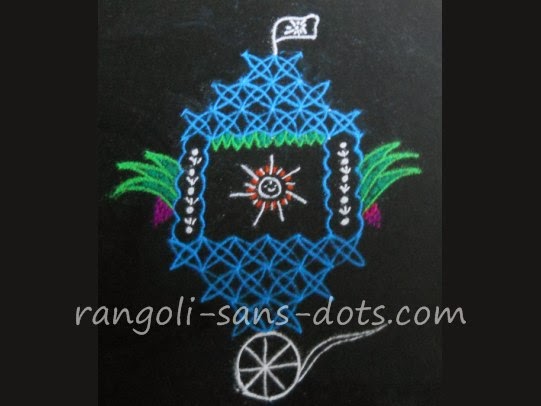Margazhi is also important due to the fact that the English New Year falls in this month and the month ends with Sankranti. Since our family lives in Tamil Nadu, we are lucky because we celebrate the English New Year, Ugadi (New Year celebrated in Andhra Pradesh, Karnataka and Maharashtra) and of course the Tamil New Year. On the new year's eve we find many rangolis big and small welcoming the new year. The words "Welcome 2013" or "Happy New Year 2013" will be written on the periphery of many Margazhi rangoli heralding the arrival of 2013. Margazhi ends with Sankranti celebrations. It is celebrated for four days in Tamil Nadu. The first day is Bhogi, 2nd day is Thai Pongal, 3rd day is Maattu Pongal and the 4th day is Kaanum Pongal . Apart from other festivities rangolis play a very important role in celebration of Sankranti or Pongal.
Almost all rangolis in the previous post - Margazhi kolam collection demand a lot of filling up to be done with rangoli powder of various colours. Hence for a change, the rangoli below simple with very few colours, a simple rangoli or rangoli border for New Year 2013. Three simple floral designs are drawn and filled with colours as shown on the top of each one simple motifs are drawn.

Pongal and Sankranthi are important festivals celebrated during January and rangoli or kolam drawn in Tamil Nadu and muggulu drawn during Sankranthi are a feast to our eyes. So some rangoli or kolam as muggulu too in the images below
Apart from the fact that rangoli are drawn daily in many parts of India and for festivals like Pongal or Sankranthi , rangoli are associated with important festivals like Navratri and Diwali. Rangoli with flower as theme are also often used as rangoli with dots or without. Rangoli designs representing flowers are drawn ( not the actual floral designs ) in some of the designs below. They may have floral designs as a part of the rangoli or as a whole. In the rangoli on the rightthe central design is drawn by drawing intersecting lines and forming the parallelogram like patterns. The edge of each one is expanded with floral designs with two petals. The gaps between the petals are filled with free hand designs. The central design is further enhanced with circular patterns of various colours. Finally the colours are filled up as shown to obtain the image shown above resulting in a colourful (green, yellow, blue ) floral pattern at the centre. The rangoli has two floral designs, the innermost one with petals of two colours and the outermost one filled with pink colour. The rangoli has been filled completely with pink outside the central design. This takes some time and demands patience also. After filling the gaps with pink floral petal motifs in orange have been added. On the outside the places between the petals has simple patterns. A simple design for all occasions and festivals.
Kolam with sugarcane and Pongal pot
Pongal paanai kolam with dots
The following pics show how to draw a simple pongal kolam with paanai or pot and sugar cane for Pongal. This is a very popular theme for Pongal so I have chosen a simple kolam design the dot pattern in 8 to 3 - idukku pulli.
Pongal paanai kolam without dots
Thai Pongal is only a few days away. So, one freehand rangoli for this Pongal season, of course with Pongal pots and sugarcane! A free hand kolam design with four colourful pots. Bright colours are have used to fill up the pot design. Then bright yellow patterns have been drawn on the colourful background.My Facebook page is Rangoli sans dots. Please remember to like it.
While Pongal is celebrated with sweet Pongal prepared from newly harvested rice. Sankranti is celebrated with what is called Tilgul . Younger generation takes the blessings of the elders of the family by falling at their feet and they in turn offer them Tilgul and bless then.Festival - Ratha Sapthami
This festival is celebrated after Pongal or Sankranti on the seventh day (hence Sapthami ) in the bright phase of the moon. A free hand rangoli of a chariot with a single wheel representing the Sun is drawn on the floor or on a wooden plank usually with kaavi (red ochre ) paste. The chariot has a single wheel with a pennant or (dwaja ) at the top. A pictorial representation of the Sun is drawn inside the chariot. This probably signifies the beginning of the harvest season. Offerings include include Sakkara Pongal . Actually it was prepared by boiling milk on a a stove lit with dried cow dung cakes. The ingredients for Pongal are added after the milk boils. The stove is placed in the sun facing east. Presently this may be practically difficult in some places.
. The rangoli or kolam is one of the types or patterns usually with a repetitive motif I have used in many rangoli designs to get the chariot design for Ratha Sapthami. It is customary to draw only a single wheel for the chariot. A toran of mango leaves on the top, rangoli patterns representing banana plants are drawn with green colour. (Both these are considered auspicious and are invariably used in festivals and functions like weddings ). A pictorial representation of the sun is drawn at the centre of the chariot. A dwaja (flag or pennant ) is added to the top. Another important festival celebrating spring that is popular in northern parts of India is Basant Panchami.Rangoli or kolam designs with dots are there





